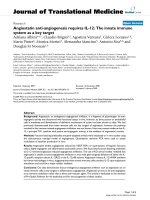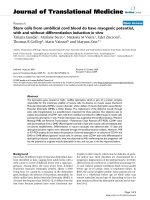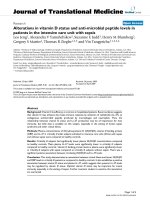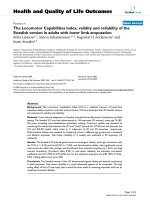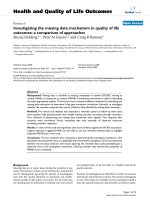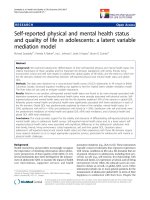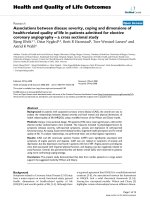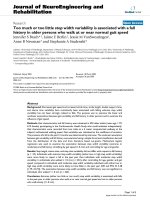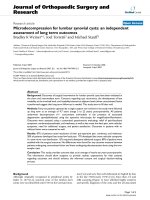báo cáo hóa học:" Percutaneous endoscopic lumbar discectomy: clinical and quality of life outcomes with a minimum 2 year follow-up" doc
Bạn đang xem bản rút gọn của tài liệu. Xem và tải ngay bản đầy đủ của tài liệu tại đây (639 KB, 8 trang )
BioMed Central
Page 1 of 8
(page number not for citation purposes)
Journal of Orthopaedic Surgery and
Research
Open Access
Research article
Percutaneous endoscopic lumbar discectomy: clinical and quality
of life outcomes with a minimum 2 year follow-up
Chan WB Peng*
1
, William Yeo
2
and Seang B Tan
1
Address:
1
Department of Orthopedic Surgery, Singapore General Hospital, Outram Road, Singapore 169608, Singapore and
2
Department of
Physiotherapy, Singapore General Hospital, Outram Road, Singapore 169608, Singapore
Email: Chan WB Peng* - ; William Yeo - ; Seang B Tan -
* Corresponding author
Abstract
Background: Percutaneous endoscopic lumbar discectomy is a relatively new technique. Very few
studies have reported the clinical outcome of percutaneous endoscopic discectomy in terms of
quality of life and return to work.
Method: 55 patients with percutaneous endoscopic lumbar discectomy done from 2002 to 2006
had their clinical outcomes reviewed in terms of the North American Spine Score (NASS), Medical
Outcomes Study Short Form-36 scores (SF-36) and Pain Visual Analogue Scale (VAS) and return
to work.
Results: The mean age was 35.6 years, the mean operative time was 55.8 minutes and the mean
length of follow-up was 3.4 years. The mean hospital stay for endoscopic discectomy was 17.3
hours. There was significant reduction in the severity of back pain and lower limb symptoms (NASS
and VAS, p < 0.05) at 6 months and 2 years. There was significant improvement in all aspects of the
Quality of Life (SF-36, p < 0.05) scores except for general health at 6 months and 2 years
postoperation. The recurrence rate was 5% (3 patients). 5% (3 patients) subsequently underwent
lumbar fusion for persistent back pain. All patients returned to their previous occupation after
surgery at a mean time of 24.3 days.
Conclusion: Percutaneous endoscopic lumbar discectomy is associated with improvement in back
pain and lower limb symptoms postoperation which translates to improvement in quality of life. It
has the advantage that it can be performed on a day case basis with short length of hospitalization
and early return to work thus improving quality of life earlier.
Introduction
The surgical treatment of lumbar disc herniation consti-
tutes a large part of orthopedic practice and it has evolved
considerably in terms of surgical technique and instru-
mentation.
Percutaneous endoscopic discectomy is a relatively new
technique for removing lumbar disc herniation. It
involves using an endoscope to visualize the disc removal.
The discectomy is performed through a posterolateral
approach using specially developed instruments. The
advantage of percutaneous endoscopic discectomy is that
the disc is approached posterolaterally through the trian-
gle of Kambin [1,2] without the need for bone or facet
resection thus preserving spinal stability. [1-4] There is
less damage to muscular and ligamentous structures
Published: 25 June 2009
Journal of Orthopaedic Surgery and Research 2009, 4:20 doi:10.1186/1749-799X-4-20
Received: 8 October 2008
Accepted: 25 June 2009
This article is available from: />© 2009 Peng et al; licensee BioMed Central Ltd.
This is an Open Access article distributed under the terms of the Creative Commons Attribution License ( />),
which permits unrestricted use, distribution, and reproduction in any medium, provided the original work is properly cited.
Journal of Orthopaedic Surgery and Research 2009, 4:20 />Page 2 of 8
(page number not for citation purposes)
allowing for faster rehabilitation, shorter hospital stay and
earlier return to function.
Although many studies [1-8] have shown the efficacy of
percutaneous endoscopic discectomy with good clinical
outcomes, there are very limited reports of how this trans-
lates to quality of life improvement and ability to return
to work. Health-related quality of life measures that are
patient-oriented (self-administered questionnaire) are
important in evaluating neurologic and spinal disorders,
especially since they affect the general status of the
patients. It has even been suggested that more widespread
use of standardized health measures may improve clinical
practice. [9,10]
The purpose of this study is to determine the outcome of
percutaneous endoscopic discectomy in terms of the
North American Spine Score (NASS) [11], Medical Out-
comes Study Short Form-36 'Quality of Health' scores (SF-
36) [9,10] and Pain Visual Analogue Scale (VAS) and how
well patients have returned to work.
Methods
From 2002 to 2006, 55 patients with percutaneous endo-
scopic discectomy performed for herniated intervertebral
disc at our instituition had data collected prospectively.
All the operations were performed by two surgeons.
Inclusion criteria were patients who had radicular symp-
toms due to discogenic lumbar nerve root compression
and failed conservative therapy. The diagnosis of lumbar
disc herniation was made on MRI and/or CT scans.
Patients with calcified discs shown on CT scans were
excluded. Patients who met the inclusion criteria were
counseled that percutaneous endoscopic lumbar discec-
tomy was a relatively new technique and offered the alter-
native of open discectomy as well. 55 patients agreed to
have percutaneous endoscopic discectomy.
Data on patient demographics, operative time, length of
hospitalisation, postoperative complications and how
soon they returned to work were obtained. In our institu-
tion, all patients who underwent spinal surgery had rou-
tine preoperative assessment and 6 month and 2 year
postoperative assessments done; the patients were
assessed based on the North American Spine Score (NASS
– Disease specific questionnaire) [11], Medical Outcomes
Study Short Form-36 scores (SF-36 – Quality of life ques-
tionnaire) [9,10] and Visual Analogue Scale (VAS) for
pain (Table 1). All patients were evaluated by an inde-
pendent observer not involved in the surgical procedure.
Statistical analysis was performed with the use of SPSS ver-
sion 10.0. Categorical data were compared with the use of
chi-square test. Non-parametric statistics were used for the
analysis of continuous variables when data were not nor-
mally distributed. Significance was defined as p < 0.05.
Technique
Preoperatively, all patients received one gram of cefazolin
intravenously as antibiotic prophylaxis and if the patient
is allergic to cefazolin, one gram of intravenous vancomy-
cin was given instead. The patients were placed prone on
a radiolucent operative table on a Wilson frame.
36 of the 55 patients (66%) were done under local
anesthesia. The skin, subcutaneous tissue, fascia and mus-
cle layers were infiltrated with 1 per cent lidocaine. For
relaxation and comfort of the patient, sedation with intra-
venous midazolam or Fentanyl was administered by the
anesthetist. 19 patients (34%) were uneasy about having
the operation performed under local anaesthesia and so
the operation was done under general anaesthesia.
Using the C-arm oriented in the postero-anterior imaging
position, the midline longitudinal line is marked on the
skin surface using a narrow metal rod. The metal rod is
then placed transversely across the center of the target
disc. A horizontal line is drawn, bisecting the disc under
evaluation. The anatomic disc center is located where the
transverse line crosses the longitudinal midline. The C-
arm is rotated to the lateral projection. The metal rod is
held along the side of the patient in the parasagittal orien-
tation at the level of the index disc. While the metal rod is
held in this position, the length from the center of that
disc to the plane of the posterior skin is recorded. This
length is used for the lateral distance of the skin entry
point from the posterior midline and this is usually about
12 to 14 cm from the midline. [12] Under fluoroscopic
guidance, an 18 gauge spinal needle is inserted such that
the needle tip is positioned at the medial pedicular line in
the anteroposterior projection and on the posterior verte-
bral line in the lateral projection. In patients done under
Table 1: Patient demographics, operative time, length of hospital
stay and duration of followup for endoscopic discectomy
Endoscopic discectomy
Age Mean 35.6 years
Range 15 – 68 years
Sex 23 female: 32 male
42% female: 58% male
Operative time Mean 55.8 minutes
Range 30 – 100 minutes
Length of hospital stay Mean 17.3 hours
Range 6 to 24 hours
Follow-up Mean 3.4 years
Range 2.0 – 6.5 years
Duration of medical leave Mean 24.3 days
Range 10 – 60 days
Journal of Orthopaedic Surgery and Research 2009, 4:20 />Page 3 of 8
(page number not for citation purposes)
local anaesthetic, a transforaminal epidural infiltration
with 1% lidocaine is injected through the spinal needle to
reduce pain and discomfort. The needle is then punctured
into the disc and an intraoperative discogram is per-
formed with a mixture of 6 ml of contrast media and 1 ml
of indigo carmine. The indigo carmine stains the patho-
logic nucleus and the annular fissure for easy discrimina-
tion through the endoscope.
A guidewire is then inserted through the needle into the
disc and the needle removed. A small stab incision is
made at the entry site of the guidewire and a tapered can-
nulated obturator is slid over the guide wire and intro-
duced gently into the foramen and into the disc. A beveled
working cannula is then introduced over the obturator
which is then withdrawn. An endoscope (Yeung Endo-
scopic Spine System – Y.E.S.S. endoscope) [13] is then
inserted through the working channel and discectomy
performed with endoscopic forceps. Discectomy is per-
formed to a location just under the apex of the herniation.
An endoscopic rongeur is used to extract the blue-stained
material creating a cavity within the disc. If a noncon-
tained extruded disc fragment is present, the anular collar
is divided, and a cutting forceps is used to perform a par-
tial anulectomy. Once a partial anulectomy has been car-
ried out, the subligamentous or extraligamentous
components of the herniation are first extracted into the
cavity within the disc and then pulled out through the
endoscope working channel. Hemostasis is performed
with bipolar diathermy (Ellman International, Hewlett,
NY) [13].
Results
The mean age of the patients was 35.6 years (range 15 –
68 years). There were 23 (41.8%) female: 32 (58.2%)
male. The mean operative time was 55.8 min (30–100
min). The mean length of hospitalization was 17.3 hours
(range 6 to 24 hours). The mean follow-up period was 3.4
years (range 2.0 – 6.5 years). All patients who were work-
ing preoperatively returned to work. The mean time to
return to work was 24.3 days (10 – 60 days). All returned
to their previous occupation (Table 1).
39 (70.9%) patients had L4L5 discectomy done, 12
(21.8%) had L5S1, 2 (3.6%) had L3L4 and 2 (3.6%) had
two levels L4L5 and L5S1 done. There were 44 (80%) disc
protrusions, 10 (18.2%) extrusions and 1 (1.8%) seques-
trated disc.
Figure 1 and 2 shows the preoperative and 6 month and 2
years postoperative NASS and VAS scores. There was sig-
nificant improvement in the NASS scores for back disabil-
ity and neurogenic symptoms and the VAS scores for back
pain and lower limb pain at 6 months and 2 years postop-
eratively compared to preoperatively (all p < 0.05). The
mean NASS score for satisfaction with treatment was 3.9
(range 1.3–5.4) at 6 months and 4.7 (range 2.5 – 5.8) at 2
years postoperation (1 = extremely dissatisfied, 6 =
extremely satisfied). Low satisfaction scores were reported
by patients who had complications or required subse-
quent operations. These included 3 patients who devel-
oped recurrent disc prolapse, 3 patients who underwent
subsequent lumbar fusion for increasing back pain and 1
patient who developed post-operative discitis. 3 patients
had recurrent disc prolapse (recurrence rate 5%). All these
patients had relief of their leg symptoms after the opera-
tion. One patient had recurrence of symptoms at 6 weeks
post-operation, another at 4 months and the third at 7
months post-operation. 2 of these patients subsequently
underwent open discectomy. Both had relief of symptoms
with no complications after the open discectomy. One
patient with recurrent disc refused operation and was
treated conservatively. 1 patient had a sequestrated disc
after endoscopic discectomy and was treated with open
discectomy.
3 patients (5%) subsequently underwent lumbar fusion
for increasing back pain despite good relief of radicular
symptoms after endoscopic discectomy. One of these
patients was a 25 year old male who presented initially
with left L4 radicular symptoms. MRI showed L4L5 and
L5S1 degenerate discs with a left L4L5 prolapsed intervet-
ebral disc. A left L4L5 endoscopic discectomy was initially
performed for him but on followup, he complained of
increasing back pain and had L4L5, L5S1 transforaminal
lumbar interbody fusion done 3 months after endoscopic
discectomy. Another was a 45 year old male who had right
L5 radicular symptoms and back pain preoperatively. MRI
showed a right L5S1 posterolateral disc prolapse. He
underwent right L5S1 endoscopic discectomy but also
had increasing back pain on followup. He eventually had
L5S1 posterior lumbar interbody fusion done 7 months
post-edoscopic discectomy. For both of these patients,
their initial radicular symptoms resolved after endoscopic
discectomy. The third patient was a 36 year old female
with left L4 radicular pain. MRI showed a L4L5 prolapsed
disc. Post- endoscopic discectomy, her radicular sump-
toms resolved. However 3 years postoperation, she com-
plained of back pain and left L4 radicular pain again.
Postoperation MRI showed diffuse L45 disc bulge and
central and lateral recess stenosis. She subsequently
underwent transforaminal lumbar interbody fusion.
1 patient developed discitis 4 days post-endoscopic dis-
cectomy. This is a 37 year old male who underwent left
L45 percutaneous endoscopic discectomy. He was dis-
charged well 1 day post-operation. However, on the 4
th
post-operative day, he complained of severe back pain
associated with mild fever. Blood tests showed raised total
white count, ESR and CRP. An MRI with contrast showed
Journal of Orthopaedic Surgery and Research 2009, 4:20 />Page 4 of 8
(page number not for citation purposes)
mainly granulation tissue. He underwent endoscopic
washout of the disc space. Tissue cultures from the disc
space grew Staphylococcus aureus. His symptoms resolved
after the washout. He was treated with intravenous Aug-
mentin for 2 weeks followed by a further 4 weeks of oral
Augmentin. He had occasional back pain at 2 years fol-
low-up. There were no complications associated with any
of the subsequent surgeries performed after endoscopic
discectomy.
Based on the SF-36 questionnaire (Figure 3), all aspects of
'Quality of Life' improved after endoscopic discectomy. At
6 months and 2 years post operation, there was significant
improvement in scores for physical function, role physi-
cal, bodily pain, vitality, social function, role emotional
and mental health (all p < 0.05). However the improve-
ment in general health scores did not reach significant dif-
ference at 6 months and 2 years postoperation.
Discussion
Conventional open surgery remains the 'gold standard'
for treating herniated intervertebral disc. However the dis-
advantages of open surgery include extensive retraction
and dissection of paraspinal muscles, longer operative
time, larger wounds and bone resection. [5,14]
Endoscopic discectomy via a percutaneous transforaminal
posterolateral approach is an alternative technique used
to treat lumbar disc herniations. Advances in instrumen-
tation now allow for a 'working channel' through which
various tools can be passed under direct endoscopic visu-
alization for the safe removal of disc material. The advan-
NASS scores pre and postoperativelyFigure 1
NASS scores pre and postoperatively.
Journal of Orthopaedic Surgery and Research 2009, 4:20 />Page 5 of 8
(page number not for citation purposes)
tages of this technique include less paraspinal
musculature trauma and smaller wounds. Bone removal is
not required to decompress the exiting nerve root and this
avoids the risk of inducing spinal instability. [2,3,15] Also
the spinal canal is not violated and therefore there is less
epidural bleeding and epidural scarring. However, unlike
other percutaneous techniques like chymopapain chemo-
nucleolysis, percutaneous laser discectomy and nucleo-
plasty, percutaneous endoscopic discectomy allows
removal of not only fragments located in the center of the
nucleus, but also fragments that have migrated posteriorly
and posteroaterally by using specially designed straight,
upbiting and deflectable forceps under endoscopic con-
trol.
Many studies have shown good to excellent clinical out-
comes after percutaneous endoscopic discectomy based
on improvement in disease-related symptoms and physi-
cal signs. [3-8] However, these are surgeon-based out-
come measures which are not related with validated
measurements of outcomes that are more relevant to
patients' quality of life and functional status. These meas-
ures place no emphasis on the patient's overall perception
of the impact of the operation on subjectively experienced
distress or well-being. To assess the impact on quality of
life in patients who undergo percutaneous endoscopic
discectomy, the SF-36 questionnaire was administered to
our patients preoperatively and at 6 months and 2 years
postoperation. Based on the SF-36 questionnaire, all
Visual Analogue Scale pre and postoperativelyFigure 2
Visual Analogue Scale pre and postoperatively.
Journal of Orthopaedic Surgery and Research 2009, 4:20 />Page 6 of 8
(page number not for citation purposes)
aspects of 'Quality of Life' scores improved after endo-
scopic discectomy compared to preoperation. There was
also significant improvement in NASS and VAS scores at 6
months and 2 years postoperation compared to preopera-
tion. Thus back pain and neurogenic symptoms are partic-
ularly disabling and are associated with significant
morbidity affecting quality of life. Hence surgical treat-
ment to improve these symptoms translates to significant
improvement in the quality of life of patients.
In our study, the mean hospital stay for endoscopic dis-
cectomy was 17.3 hours. Other studies have also shown
that endoscopic discectomy can be performed on an out-
patient basis and discharged within 24 hours. [14,15] The
median hospital stay for patients treated with conven-
tional open discectomy range from 3 to 4 days. [16]
Therefore, endoscopic discectomy has the advantage of
shorter hospitalization compared to open approaches. In
our study the mean time to return to work is 24.3 days and
all patients returned to their previous occupation. Other
studies also showed that the majority of patients were able
to return to their previous occupation within 1 month,
and that the period of disability is shorter for endoscopic
discectomy compared to open discectomy. [3,5,14] Thus
endoscopic discectomy is associated with short hospitali-
zation and earlier return to work and patients can achieve
improved quality of life earlier.
Most studies report that performing this procedure under
local anesthesia with constant intraoperative feedback
from patients is important in reducing the risk of neural
damage. [2,3,5-8,15,17] In our study, 66% of our patients
were done under local anesthesia and 19 patients were
done under general anesthesia. We feel that although the
SF-36 scores pre and postoperativelyFigure 3
SF-36 scores pre and postoperatively.
Journal of Orthopaedic Surgery and Research 2009, 4:20 />Page 7 of 8
(page number not for citation purposes)
potential risk of nerve damage should be recognized, per-
cutaneous endoscopic discectomy can still be performed
safely under general anesthesia as long as the approach to
the disc is kept within the triangle of Kambin [2]. How-
ever, this requires careful reading of the preoperative
imaging studies and intraoperative fluoroscopy. Also
when the endoscope is inserted, it is important to exam-
ine that the nerve is not entrapped. We felt that if the
endoscope is introduced at the safe triangle of Kambin,
[2] the risk of nerve damage was low. We did not have any
neurological deficit in all the patients done under general
anesthesia. The advantage of general anesthesia is that
there is no patient discomfort and intraoperative pain that
is associated with performing the procedure under local
anesthesia.
3 patients had recurrent disc prolapse (recurrence rate
5%), of which 2 had open discectomy. 1 patient was
found to have a sequestrated disc post-endoscopic discec-
tomy and had open microdiscectomy subsequently.
Recurrence rate of lumbar disc herniation after open dis-
cectomy has been reported as 5–11% and most have been
treated with a repeated discectomy through the same
approach as the initial surgery.[18,19] However, repeat
open discectomy through the same initial approach could
produce less satisfactory results with approach related
complications. Scar tissue from the previous open surgery
makes repeat discectomy more difficult with increased
risk of dural tear or nerve injury. [20,21] In our study,
when open discectomy was performed for recurrent disc
prolapse/sequestrated disc after previous endoscopic dis-
cectomy, there was no scar tissue encountered and there
were no associated complications. In these patients, the
endoscopic procedure did not seem to have a disadvanta-
geous influence on the outcome of subsequent open sur-
gery since all had resolution of their symptoms. Other
studies [5,15] also showed that successful outcomes can
be achieved in repeat operations for failed percutaneous
endoscopic discectomy.
3 patients subsequently underwent lumbar intervertebral
body fusion for increasing low back pain despite resolu-
tion of their initial radicular symptoms. Thus while percu-
taneous endoscopic discectomy is effective in relieving leg
symptoms, it is less effective in treating back pain and this
has to be communicated to the patients.
In this study, the complications for endoscopic discec-
tomy include 1 case of discitis and 1 case of sequestrated
disc, giving a complication rate of 3.6%. It has been
reported that the overall complication rate for this kind of
surgical procedure averages 2.6%.[8,22] The complica-
tions reported include dysthesia, nerve root or vascular
injury, postoperative infections and dural
tear.[6,8,13,17,22,23] The incidence of failures and com-
plications in this group of patients was similar to that
experienced with conventional open surgery.[24]
Conclusion
Percutaneous endoscopic lumbar discectomy is a safe and
efficacious technique to relieve symptoms of herniated
discs and this improvement in back pain and leg symp-
toms translates to improvement in quality of life. It has
the advantage that it can be performed on a day case basis
with shorter length of hospitalization and early return to
work thus improving quality of life earlier. This is impor-
tant because patients become candidates for lumbar disc
herniation surgery to obtain immediate pain relief and to
improve their quality of life.
Competing interests
The authors declare that they have no competing interests.
Authors' contributions
CWBP performed case collection, data analysis, literature
review and wrote article. WY performed case and data col-
lection. SBT supervised and helped in manuscript prepa-
ration. All authors read and approved the final
manuscript.
References
1. Kambin P, Brager M: Percutaneous Posterolateral Discectomy.
Anatomy and Mechanism. Clin Orthop 1987, 223:145-54.
2. Kambin P, Gellman H: Percutaneous Lateral Discectomy of the
Lumbar Spine: A Preliminary Report. Clin Orthop 1983,
174:127-32.
3. Kambin P, Sampson S: Posterolateral Percutaneous Suction-
Excision of herniated lumbar intervertebral discs. Report of
Interim results. Clin Orthop 1986, 207:37-43.
4. Kambin P, Schaffer J: Percutaneous Lumbar discectomy.
Review of 100 patients and current practice. Clin Orthop 1989,
238:24-34.
5. Mayer HM, Brock M: Percutaneous endoscopic discectomy:
Surgical technique and preliminary results compared to
microsurgical discectomy. J Neurosurg 1993, 78:216-25.
6. Ditsworth DA: Endoscopic transforaminal lumbar discectomy
and reconfiguration: A postero-lateral approach into the spi-
nal canal. Surg Neurol 1998, 49:588-98.
7. Lew SM, Mehalic TF, Fagone KL: Transforaminal percutaneous
endoscopic discectomy in the treatment of far-lateral and
foraminal lumbar disc herniations. J Neurosurg. 2001, 94(2
Suppl):216-220.
8. Yeung AT, Tsou PM: Posterolateral Endoscopic Excision for
Lumbar Disc Herniation. Surgical Technique, Outsome, and
Complications in 307 Consecutive Cases. Spine 2002,
27:722-31.
9. Dahl B, Gehrchen PM, Kiaer T, Blyme P, Tondevold E, Bendix T:
Nonorganic pain drawings are associated with low psycho-
logical scores on the preoperative SF 36 questionnaire in
patients with chronic low back pain. Eur Spine J 2001, 10:211-4.
10. Epstein NE, Hood DC, Bender JF: A comparison of surgeons
assessment to patient's self analysis (short form 36) after far
lateral lumbar disc surgery. An outcome study. Spine 1997,
22:2422-8.
11. Daltroy LH, Cats-Baril WL, Katz JN, Fossel AH, Liang MH: The
North American Spine Society Lumbar Spine Outcome
Assessment Instrument: reliability and validity tests.
Spine
1996, 21:741-9.
12. Ruetten S, Komp M, Godolias G: An extreme lateral access for
the surgery of lumbar disc herniations inside the spinal canal
using the full-endoscopic uniportal transforaminal approach-
Publish with BioMed Central and every
scientist can read your work free of charge
"BioMed Central will be the most significant development for
disseminating the results of biomedical research in our lifetime."
Sir Paul Nurse, Cancer Research UK
Your research papers will be:
available free of charge to the entire biomedical community
peer reviewed and published immediately upon acceptance
cited in PubMed and archived on PubMed Central
yours — you keep the copyright
Submit your manuscript here:
/>BioMedcentral
Journal of Orthopaedic Surgery and Research 2009, 4:20 />Page 8 of 8
(page number not for citation purposes)
technique and prospective results of 463 patients. Spine 2005,
30:2570-8.
13. Yeung AT: The evolution of percutaneous spinal endoscopy
and discectomy: State of the art. Mt Sinai J Med 2000, 67:327-32.
14. Hermantin FU, Peters T, Quartararo L: A prospective, rand-
omized study comparing the results of open discectomy with
those of video-assisted arthroscopic microdiscectomy. J Bone
Joint Surg Am 1999, 81:958-65.
15. Schaffer JL, Kambin P: Percutaneous posterolateral lumbar dis-
cectomy and decompression with a 6.9 mm cannula: Analy-
sis of operative failures and complications. J Bone Joint Surg Am
1991, 73:822-31.
16. Maroon JC, Kopituk TA, Schulhof LA, Abla A, Wilberger JE: Diagno-
sis and microsurgical approach to far-lateral disc herniation
in the lumbar spine. J Neurosurg 1990, 72:378-82.
17. Ahn Y, Lee SH, Park WM, Lee HY, Shin SW, Kang HY: Percutane-
ous Endoscopic Lumbar Discectomy for Recurrent Disc Her-
niation: Surgical Technique, Outcome, and Prognostic
Factors of 43 Consecutive Cases. Spine 2004, 29:E326-32.
18. Cinotti G, Roysam GS, Eisenstein SM, Postacchini F: Ipsilateral
recurrent lumbar disc herniation. A prospective, controlled
study. J Bone Joint Surg Br 1998, 80:825-32.
19. Suk KS, Lee HM, Moon SH, Kim NH: Recurrent lumbar disc her-
niation: results of operative management. Spine 2001,
26:672-6.
20. Kim SS, Michelsen CB: Revision surgery for failed bck surgery
syndrome. Spine 1992, 17:957-60.
21. Stolke D, Sollmann WP, Seifert V: Intra- and postoperative com-
plications on lumbar disc surgery. Spine 1989, 14:56-9.
22. Kambin P, Casey K, O'Brien E, Zhou L: Transforaminal arthro-
scopic decompression of lateral recess stenosis. J Neurosurg
1996, 84:462-467.
23. Blankstein A, Rubinstein E, Ezra E, Lokiec F, Caspi I, Horoszowski H:
Disc Space Infection and Vertebral Osteomyelitis as a com-
plication of Percutaneous Lateral Discectomy. Clin Orthop
1987, 225:234-237.
24. Stolke D, Sollmann WP, Seifert V: Intra- and postoperative com-
plications on lumbar disc surgery. Spine 1989, 14:56-9.
